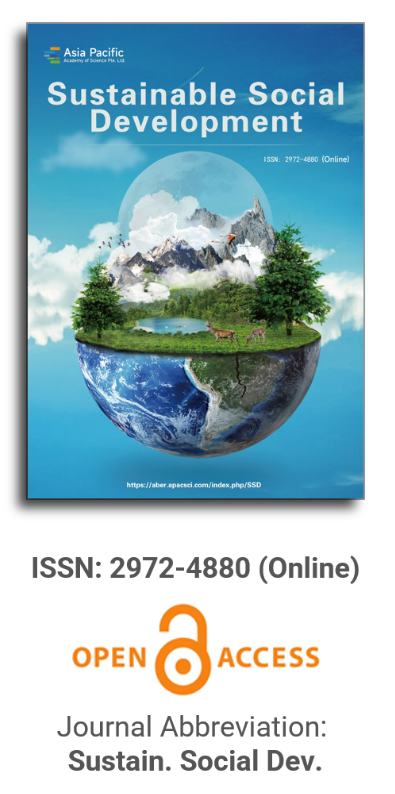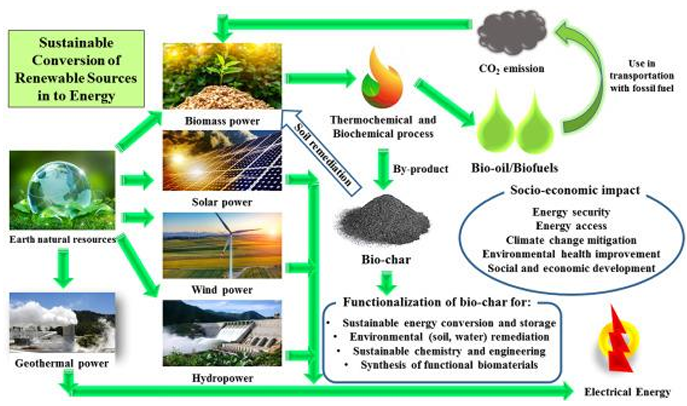
Asia Pacific Academy of Science Pte. Ltd. (APACSCI) specializes in international journal publishing. APACSCI adopts the open access publishing model and provides an important communication bridge for academic groups whose interest fields include engineering, technology, medicine, computer, mathematics, agriculture and forestry, and environment.

Sustainable social development requires profound changes in how humans perceive our relationship with the natural environment, and how we structure our economic, social, and political systems accordingly. It's about cultivating a deep ethic of environmental stewardship, social equity, and long-term thinking within both individual mindsets and collective institutions. This issue presents a diverse range of research examining the intersections between human behavior, environmental impacts, and strategies for promoting sustainable development, offering a multidisciplinary perspective on the complex social, cultural, and environmental dimensions of sustainable development. By better understanding the human behavioral dimensions, we can design more effective, holistic strategies to build a more sustainable future.
Full Issue
| View or download the full issue |
People’s expectations for businesses’ social responsibility are rising as environmental and social issues are gaining more and more concerns worldwide. Furthermore, many big businesses need to take ESG (Environmental, Social, and Governance) factors into account when making decisions due to the growing trend of influence investing. What is ESG? What’s the advantage of ESG? What’s the relationship between ESG and sustainable development? These questions will be answered in this article.
Issue release: 30 April 2024
Personality may influence food waste through planned as well as instinctive behaviour. Considerable attention has been devoted to planned behaviour because instincts are difficult to measure using attitudes, behaviours, and intentions. Our study intends to include the instinctive side of behaviour. We used a survey of 339 Swiss households regarding the amount of food waste generated to explore the pathways of how personality influences food waste behaviour. A regression analysis showed that agreeableness and conscientiousness are negative predictors of the amount of food waste. However, the different behaviour of conscientious consumers can be explained by an intermediate variable, whereas the different behaviour of agreeable people can’t. This lack of link can be due either to missing suitable intermediate variables or to the role of instinctive behaviour.
Issue release: 30 April 2024
This study assessed the ecological consequences of heavy metal contamination in soil induced by spent engine oil (SEO) and palm oil mill effluents (POME) in Ebonyi State, Nigeria. Concentrations of zinc, nickel, mercury, manganese, lead, iron, copper, chromium, and cadmium were analyzed across contaminated and uncontaminated sites. The research, conducted at Ebonyi State University’s Presco Campus, employed rigorous sampling and analytical methods. Results revealed that soil contaminated with spent engine oil effluent exhibited elevated mean concentrations of zinc, nickel, manganese, lead, iron, copper, chromium, and cadmium compared to the palm oil mill effluent and control sites. Conversely, mercury concentrations were higher in soil contaminated with palm oil mill effluent. Comparative analyses highlighted unique dynamics, such as lead concentrations being highest at the control site, challenging general trends observed for other metals. Importantly, none of the mean concentrations exceeded the WHO acceptable limits at the time of the study, indicating compliance with internationally recognized safety thresholds. The findings underscore the need for tailored environmental management strategies, considering specific contaminants associated with each effluent type. Continuous monitoring is crucial to ensure sustained adherence to safety standards and prevent potential future exceedances. This study contributes a valuable understanding of the nuanced ecological impact of industrial effluents on soil quality in Nigeria, emphasizing the importance of sustainable practices for environmental protection.
Issue release: 30 April 2024
In the past few decades, due to the global environmental crisis humanity is facing, a sudden growth in environmental policies and sustainability strategies has been registered. This article discusses two of such policies, namely that of Gross National Happiness (GNH) in the Himalayan country of Bhutan and the inclusion of the concept of Buen Vivir (BV) in the Bolivian Constitution, through a critical analysis—based on political ecology approaches—of their implementation within state policy and their wider implications within the global discourse on the so-called “sustainable development” paradox. This paper highlights the role that the aforementioned policies might play in the path to decolonization, seeing as how they draw inspiration from their own local contexts and values instead of those provided by the Global North, more specifically focusing on their ancestral and traditional knowledge to supposedly guide the countries’ policy-making process. Although several points of criticism are identified in both policies, innovativeness is detected in their potential to offer alternative views on human wellbeing, both for global southern and global northern contexts, as their original intent would be to remarkably operate outside of the Western framework of development based on Gross Domestic Product (GDP) and economic growth. GNH appears to be mostly oriented toward supporting political national budget discussion and allocation, while BV acts at a higher level (constitutional), thus also inspiring overall politics.
Issue release: 30 April 2024
This article aims to examine the relationship between art, science, technology, and the environment to transform the vitality of developing methodological strategies through education for sustainable development. The main goal is to generate a greater importance of a new demand through the selective didactic proposal in different educational systems, both for school education and for higher education. The new methodological foundations for rethinking and reviewing the knowledge of educational research through documentary study and sustainability in the general educational system. This model of sustainable development in education—schooling and higher education—involves actions and activities based on the concept of sustainable development. There is a new search for different modalities and educational subjects for sustainable development. The new methodological orientation in both educational systems makes it possible to create teaching tools that address sustainability, tolerance, and self-care responsibility toward the future of climate change.
Issue release: 30 April 2024
Subject area: This case allows management students to engage with the implementation of sustainable supply chain management practices both at the macro and micro levels. The decision to make supply chain operations sustainable is no longer an option for many organisations. The question is not “should we do it? but how can we implement sustainable supply chain management practices?” Study level/applicability: This case has been developed for management institutes and schools that teach undergraduate and postgraduate programmes. Sustainability has become an essential module in management curriculums; thus, this case is relevant for management programmes (operations, logistics, supply chain management, business studies, and management). Case overview: This case highlights the achievements of Rameshwaram (plant head at the Nirlep factory of Bajaj Electrical Ltd.) and his team for successfully completing a sustainability initiative—Zero Waste to Landfill (ZWTL)—in a short span of six months. This case is divided into two parts: the first part presents their initiatives in making all echelons of their supply chain sustainable; the second part specifically outlines how they achieved Zero Waste to Landfill in one of the manufacturing operations in a short span of six months. A cross-functional team was put together to plan and implement the ZWTL project. Initially, the team encountered many challenges, such as poor quantification of waste at the factory site, inadequate infrastructure for waste segregation, a lack of vendor participation, and extensive training of vendors and employees as needed to ensure project compliance. However, with sustained efforts, the goal was achieved. As a result, BEL became the first Indian company in the sector to achieve 99% diversion from landfills for the waste generated at the Nirlep factory in 2021. It translated into a dramatic reduction of adverse environmental impacts. Monetary benefits were also realized by utilizing the waste for commercial use. As customers across the globe appreciated their efforts, their brand equity increased severalfold. Expected learning outcomes: The case establishes that supply chain sustainability initiatives can never be completely successful without the unanimous engagement of internal and external stakeholders. In present times, the foundation of business performance has moved away from financial profitability only to the “triple bottom line,” which incorporates environment and social responsibility. The choice between commercial viability and sustainability is no longer available to the companies, as they need to integrate environmental and social goals within their businesses and provide transparency on sustainable performance and value to not only all stakeholders but also policymakers and consumers.
Issue release: 30 April 2024
This paper aims to review the literature on ESG (environment, social, and governance) finance based on the Scopus database and synthesize the review. Three advantages of embracing ESG in corporate finance are identified based on the literature reviewed. First, this positively influences financial investment decisions; second, it can leverage advancements in technology and innovations; and third, it can create proactive risk management. Overall, it is still believed and conceptually accepted that integrating ESG criteria within the investment decision-making process brings a consolidated approach to the investment strategy, aligning social and environmental benefits with financial returns and driving positive performance and shareholder value in the long run.
Issue release: 30 April 2024
This study aimed to examine the literature on Pasir Gudang, analyse the gathered material, and identify areas lacking knowledge. The literature research reveals that the published studies may be classified into hydrological, monitoring and forecasting, social, economic, and environmental issues. Nevertheless, the subjects of conservation, preservation, pollution recovery, and bioremediation, particularly environmental, social, and governance (ESG) concerns, have been of recent interest. Thus, these information gaps are strongly advised to be addressed in future research in and around the busy Pasir Gudang industrial sector.
Issue release: 30 April 2024
Poverty and hunger have become global crises, especially in Africa. African political leaders have continued to mismanage public resources, while many have embezzled public funds. Some have misappropriated public funds and borrowed senselessly from the West, making it difficult for them to dissociate themselves from the dictates of Western powers. Another factor that has impoverished Africa is intertribal war, caused mainly by leadership negligence because of their political calculations. Other problems that have contributed to the escalating poverty level in Africa are political instability, economic downturn, and religious intolerance. Despite the poverty crisis in Africa, the church has remained proactive in alleviating poverty there. The church has been missional in its approach, but with its missionaries’ efforts, it has had to become strategic in contemporary times to record successes in its missions’ endeavours in Africa, especially in Nigeria. Therefore, this paper attempts to explain the anthropological strategies that mission agencies and missionaries employ to record success in the face of poverty escalation in Africa. This will be achieved by explaining the concept of poverty in Africa, historically examining missions’ success in Africa, and identifying anthropological strategies employed by missionaries in Africa despite the escalating level of poverty in Africa. This study reveals strategies for mission success to ensure missionaries of different denominations are aware of previous achievements and want to do more.

Prof. Kittisak Jermsittiparsert
University of City Island, Cyprus






It is with deep regret that we announce the cancellation of the Forum on Sustainable Social Development & Computing and Artificial Intelligence, originally scheduled for June 15, 2025.


 Open Access
Open Access